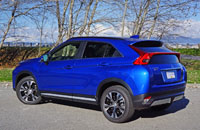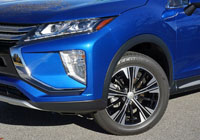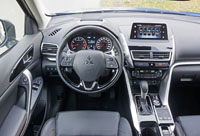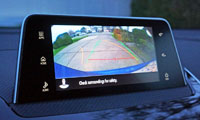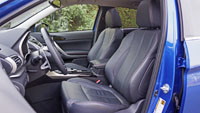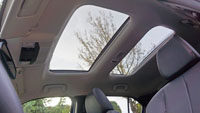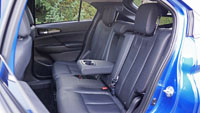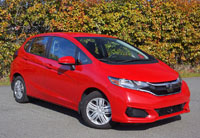
The subcompact Fit is Honda’s most affordable new car, but despite its inexpensive price tag it may possibly be your best option even if you were willing to spend more.
Ok, I’d understand if someone would rather own an HR-V, being that crossovers are all the rage these days, and the little Honda SUV boasts an identically innovative second row. This rear Magic Seat provides even more cargo space in the HR-V, but the Fit can be had for only $15,590 compared to the base HR-V’s $23,300 window sticker, so it’s a smarter choice for entry-level active-lifestyle buyers trying to pinch their nickels and dimes.

The 2019 Fit used for this review was in LX trim, upgraded yet further with its optional continuously variable transmission (CVT), causing its retail window sticker to move up from $18,990 for the six-speed manual to $20,290. Upgrades to the LX CVT include all the LX manual’s features, such as a body-coloured rear rooftop spoiler, an auto-up/down driver-side window, illuminated steering wheel audio and cruise controls, a larger infotainment touchscreen with Android Auto and Apple CarPlay smartphone integration, a multi-angle rearview camera with dynamic guidelines (the base camera doesn’t include the moving guidelines), Siri Eyes Free, text message reading/responding, Wi-Fi tethering, an extra USB device connector (resulting in two), filtered air conditioning, heated front seats, a centre console with an armrest and storage bin, the HondaLink Assist automatic emergency response system, a cargo cover plus more, while it also includes standard Honda Sensing technologies, such as forward collision warning with automatic emergency braking, lane departure warning, lane keep assist, road departure mitigation, an ECON mode button, etcetera.
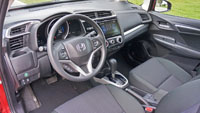
I should point out the LX includes the majority of base DX features as well, an abbreviated list including auto-off multi-reflector halogen headlights, LED brake lamps, heatable powered door mirrors with body-colour caps, body-coloured door handles, remote access, power locks and windows, intermittent front windshield wipers, a rear window wiper, tilt and telescopic steering, a four-speaker 160-watt AM/FM/MP3/WMA audio system, Bluetooth phone connectivity with audio streaming, and more.
The Fit hasn’t always met everyone’s design criteria, but tell me what subcompact hatchback pushes all the buttons? Possibly the Kia Rio? Nevertheless, this third-generation Fit is certainly more appealing visually than the yawn-inducing original and slightly better looking second version, or at least that’s how I see it, while this most recent version, refreshed just last year, includes more of Honda’s new sharp-edged design language for an even better look.
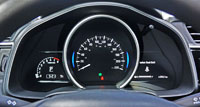
The 2018 mid-cycle makeover also came with even sharper looking new Sport trim that I reviewed last year, this model’s $19,990 price point placed directly in the middle of four additional trim lines including the base DX, my tester’s LX designation, a $22,290 EX model, and finally the top-tier EX-L NAVI, which starts at $24,390. As much as I prefer the Sport to the others visually, thanks to gloss-black alloys and yet more inky black trim with red highlights around its body, plus its sporty red on black interior motif, the LX might be the smarter choice for those on a budget.
The features list above proves my point, as few necessary items have been left off the menu (although I would’ve like to have also had proximity access and pushbutton start/stop). Even more important in this class are low running costs, general comfort and overall practicality, and time spent with any Fit trim line will quickly have you appreciating that it performs well in each and every category.
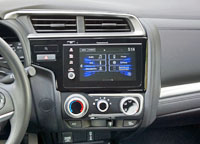
Once inside any Fit, old or new, or better yet having lived with one for enough time to experience how brilliantly practical it is, you’ll appreciate that styling matters a lot less than choosing the right car to accomplish the things you want to do. It’s the pragmatic minivan argument shrunken down to genuinely small proportions, yet play around awhile with its Magic Seat configurations and you’ll quickly understand that size really doesn’t matter when innovative engineering is factored in.
Those unfamiliar with the Fit’s second-row Magic Seats should pay close attention, as nothing in this class even comes close. The rear cushions rest atop hooped metal legs that can be folded upward and locked into place against the backrests, similar to those in some pickup trucks. This results in 139 litres (4.9 cubic feet) of cargo space for taller items such as bicycles or potted plants, while the 470-litre (16.6 cubic-foot) rear luggage compartment is still available for additional gear. Lay the rear seats into the floor and you’ll have 1,492 litres (52.7 cubic feet) of luggage space available, which is plenty for this class. In fact, the Fit’s total cargo capacity is 184 litres (6.5 cubic feet) more accommodating than Honda’s larger compact Civic Hatchback. Not bad for a subcompact.
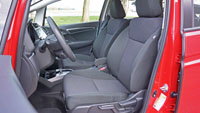
It’s all about overall height and a low loading floor, which makes it ideal for driver and passengers too. The Fit’s two front seats are a bit firmer than the class average, but still very comfortable and supportive, while the tilt and telescopic steering column’s rake and reach worked very well for my long-legged and short-torso body type, and should do likewise for all sizes. Similarly the rear outboard seats provide good comfort too, plus roominess in back is excellent. Sitting directly behind the driver’s seat when set up for me, I had about five inches left over in front of my knees, ample room for my legs and feet, almost four inches over my head, and four-plus next to my hips and shoulders.
Back behind the wheel, the primary instrument cluster features a big circular speedometer at centre, its analogue outer ring filled in the middle with a useful multi-information display, while TFT displays bookended each side of the cluster with colourful graphics that made it appear more upscale than the Fit’s price point would suggest. High quality switches on the steering wheel spokes control the multi-info display and more.
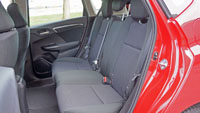
Look over to the Fit’s centre stack and one of the better infotainment touchscreens will be staring back. It’s complete with intelligently organized digital tile buttons that open up well designed function panels, with the audio system interface complemented by a classic rotating power/volume knob that certainly appreciated when driving. Underneath the touchscreen is a small cluster of manually operated heating and ventilation controls featuring big dials with nice grippy knurled metal-look edges, the asymmetrical design quite attractive.
While nice on the eyes, I’m not going to try and pretend the Fit is attempting to portray anything but an entry-level car. As you might expect, the dash top is comprised of hard composite as are many other cabin surfaces, but Honda surprisingly went further than most subcompact competitors when finishing off the lower instrument panel ahead of the front passenger, which gets a lovely sculpted soft-touch bolster. Also unexpected, the opposite side of the dash includes a pop-out cupholder level to the steering wheel, perfectly placed for easy access while driving. It sits just behind the corner air vent too, which means it warms up whatever is inside when the heat is on, or cools it off when the A/C is blasting, ideal unless you want something kept at room temperature.
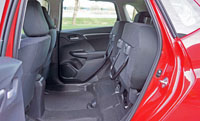
Another oddity in this class, previously noted Sport trim and the two models above actually include a paddle shifters on the steering wheel, which says a fair bit about the Fit’s fun-to-drive character. Behind its edgy new grille is a perky 1.5-litre four-cylinder that delivers a robust 130 horsepower and 114 lb-ft of torque when mated up to the manual transmission, or 128 horsepower and 113 lb-ft of torque when upgraded with the CVT. These numbers make it one of the most potent base subcompact models available, with just one rival making more in its entry-level trim. It results in more zip off the line than you might have guessed, particularly when at the wheel of the manual, although the CVT provides decent get-up-and-go too, along with good passing performance on the highway and even enough to power away from corners when slaloming through tight serpentine stretches.
Yes, I know this is a subcompact commuter car and not remotely close to a hot hatch, but its front MacPherson strut and rear torsion beam suspension holds its lane with ease even when pushing hard, only getting a bit unruly when asking too much from its narrow, tall design and 15-inch steel wheels on 185/60 all-seasons. The ride is good mind you, the Fit having been designed more for bushwhacking through the urban jungle than fast-paced mountainside passes.

Now that we’re talking about putting on daily miles, the 2019 Fit is estimated to get 8.1 L/100km in the city, 6.6 on the highway and 7.4 combined with its manual, and an even thriftier 7.0 city, 5.9 highway and 6.5 combined with the CVT. A few competitors provide slightly better efficiency, but nothing that offers the Fit’s superior performance, particularly when comparing automatic transmission equipped cars.
In the end, Honda’s Fit is one of the subcompact segment’s best driving cars, while it’s also extremely efficient and hands-down the most practical people/cargo hauler in its class, let alone all car categories. Factoring in its all-round comfort, impressive list of convenience and safety features, plus Honda’s excellent reputation for dependability and strong residual values, and it’s hard to argue against it. In fact, I’ve probably recommended the Fit to more new car buyers than any other model, and will likely continue to do so when the next model arrives later this year.
That’s right, the 2020 Fit will be dramatically redesigned, which means Honda will be discounting this 2019 model. So make sure to check out all the latest rebate info for this 2019 model right there on CarCostCanada. Fortunately for you, we have all the available rebates, including dealer invoice pricing, so you can prepare yourself before negotiating with your local retailer. You can save up to $1,000 in additional incentives on this 2019 model, so be sure to click here to learn more about these savings, as well as all the other trims Honda has on offer, plus available packages and individual options.
Story credit: Trevor Hofmann
Photo credit: Karen Tuggay


